Melipona quadrifasciata
| Resource Type | Organism |
|---|---|
| Genus | Melipona |
| Species | quadrifasciata |
| Description | Melipona quadrifasciata is a eusocial bee in the hymenopteran family Apidae. This species belongs to the Meliponini tribe of stingless bees, which is the only other lineage of bees with a complex social organization, comparable to that of the honey bees in the Apini tribe [1]. Similar to honey bees, M. quadrifasciata colonies are perennial and have a single reproductive queen with many non-reproductive workers. Several aspects of the social behavior of M. quadrifasciata differ substantially from that of honey bees, however. First, M. quadrifasciata colonies typically have 300-400 workers and are thus much smaller than honey bee colonies [1]. Second, like all stingless bees, M. quadrifasciata workers provision cells with all the pollen and nectar the larvae will need to consume during development at the time the queen lays the egg [1]. Third, whether a female develops as a queen or a worker has both a genetic and environmental (i.e., larval diet) component [2]. Finally, M. quadrifasciata foragers recruit nestmates to food sources, but are limited in how well they can communicate distance [3]. M. quadrifasciata is found throughout southeastern coastal Brazil, where they nest in tree holes, abandoned mud bird nests, or in the ground [1]. These bees are also kept for greenhouse pollination and honey harvesting, and thus play an important role in agriculture in Brazil. References cited |
| Publication | Kapheim KM, Pan H, Li C, Salzberg SL, Puiu D, Magoc T, Robertson HM, Hudson ME, Venkat A, Fischman BJ, Hernandez A, Yandell M, Ence D, Holt C, Yocum GD, Kemp WP, Bosch J, Waterhouse RM, Zdobnov EM, Stolle E, Kraus FB, Helbing S, Moritz RF, Glastad KM, Hunt BG, Goodisman MA, Hauser F, Grimmelikhuijzen CJ, Pinheiro DG, Nunes FM, Soares MP, Tanaka ÉD, Simões ZL, Hartfelder K, Evans JD, Barribeau SM, Johnson RM, Massey JH, Southey BR, Hasselmann M, Hamacher D, Biewer M, Kent CF, Zayed A, Blatti C, Sinha S, Johnston JS, Hanrahan SJ, Kocher SD, Wang J, Robinson GE, Zhang G. Social evolution. Genomic signatures of evolutionary transitions from solitary to group living.. Science (New York, N.Y.). 2015 Jun 05; 348(6239):1139-43. |
| Organism Image |  |
| Image Credit | Thiago Mlaker, Public Domain. View source |
 An official website of the United States government.
An official website of the United States government.
